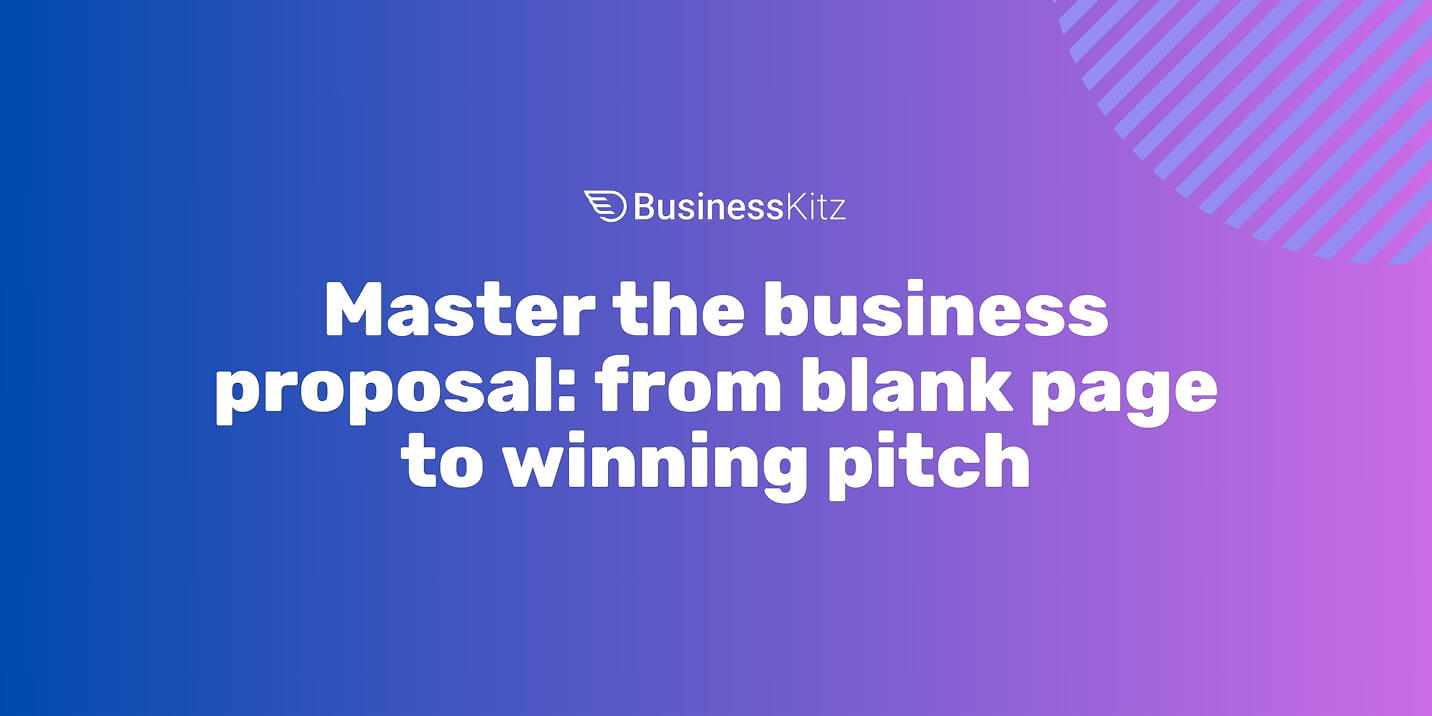
Picture this: you've just had a brilliant meeting with a potential client who's interested in your services, but they need a formal proposal before moving forward. The clock's ticking, and you're staring at a blank page wondering where to start. Sound familiar? You're not alone—research shows that sales teams spend 73% more time creating proposals without proper tools, often losing deals to faster competitors. Whether you're a freelancer pitching your first project or an established business pursuing a major contract, knowing how to write a compelling business proposal can make the difference between winning the deal and watching it slip away. Let's transform your proposal writing from a time-consuming challenge into your competitive advantage.
We've helped businesses save $55m with our all-in-one platform. Get instant access to this template and 115+ others, plus AI-powered document creation, starting completely free.
A business proposal is a formal document that outlines your products, services, or solutions to a prospective client, partner, or investor. Unlike a business plan that focuses on your company's internal strategy, a proposal is your chance to demonstrate exactly how you'll solve a specific client's problem or meet their needs.
Think of it as your written sales pitch—a strategic tool that showcases your understanding of the client's challenges and positions your business as the ideal solution. Every proposal should answer three fundamental questions: What problem are you solving? How will you solve it? Why should they choose you over competitors?
Business proposals come in three main varieties. Formally solicited proposals respond to official Requests for Proposals (RFPs) with detailed requirements.
The beauty of a well-crafted proposal lies in its dual purpose: it demonstrates your professionalism while building trust through clear communication and transparent pricing. For businesses across all industries—from creative agencies to consulting firms—proposals are the bridge between initial interest and signed contracts.

Creating a professional business proposal requires including specific elements that guide readers through your pitch logically and persuasively. Studies indicate that proposals with attractive cover pages convert 45% better than those without, highlighting the importance of getting every component right.
Your title page is your first impression—make it count. Include your company name and logo, the client's details, the date, and a compelling proposal title. Keep it clean, professional, and aligned with your brand identity. The introduction should immediately acknowledge the client's needs and preview how you'll address them.
This is your elevator pitch in written form. In one or two paragraphs, summarise the client's challenge, your proposed solution, and the key benefits they'll receive. Many decision-makers read only this section, so make every word count by focusing on outcomes rather than features.
Demonstrate a deep understanding of your client's challenges. Use specific details from your research or conversations to show you've listened carefully. This isn't about showcasing your expertise—it's about proving you understand their unique situation and pain points.
Present your solution as the logical answer to their problems. Break down your approach into clear phases or deliverables, explaining not just what you'll do but how it directly addresses each challenge. Use visuals, diagrams, or examples to make complex solutions easier to grasp.
Provide a realistic project schedule with key milestones and deliverables. Be specific about dates and dependencies, but build in reasonable buffers. Clients appreciate transparency about timing, and a well-structured timeline demonstrates your project management capabilities.
Present your pricing clearly with a detailed breakdown of costs. Whether you're charging by project, hourly, or retainer, explain what's included and what constitutes additional work. Consider offering multiple pricing tiers to give clients options while potentially increasing deal value.
Include payment terms, intellectual property agreements, confidentiality clauses, and project boundaries. Be clear about what's included and what would incur additional charges. This section protects both parties and sets expectations from the start.
Include case studies, testimonials, or client logos that demonstrate your track record. Research confirms that social proof significantly increases proposal acceptance rates by building trust and credibility before you've even started working together.

Before writing a single word, invest time in understanding your prospective client's business, industry, challenges, and goals. Review their website, annual reports, and recent news. Schedule a discovery call to ask specific questions about their needs, budget, timeline, and decision-making process, if possible.
Document everything you learn—specific pain points, preferred outcomes, industry terminology they use, and any concerns about previous vendors. This research becomes the foundation for a highly personalised proposal that resonates with their specific situation.
Select a proposal format that matches your brand while remaining functional and easy to navigate. For straightforward projects, a concise 3-5 page proposal might suffice. Complex enterprise solutions may require detailed proposals with multiple sections and appendices.
Modern proposals often include interactive elements or are delivered through proposal software that tracks engagement. Whatever format you choose, ensure it's professional, scannable, and optimised for both digital viewing and printing.
Start your executive summary by acknowledging the client's current situation and challenges. Then, briefly introduce your solution and its key benefits. Close with a clear value proposition that differentiates you from competitors.
Keep it concise—ideally under 250 words—and write it last, after you've developed the full proposal. This ensures your summary accurately reflects the complete solution while maintaining focus on what matters most to the client.
Break your solution into logical phases or components, explaining how each element addresses specific client needs. Use clear headings, bullet points, and visual aids to improve readability. Avoid jargon unless you're certain the client uses those terms regularly.
Include enough detail to demonstrate competence without overwhelming readers. Focus on outcomes and benefits rather than just listing features or services. Show how your approach minimises risk and maximises their return on investment.
Develop a project timeline that balances ambition with achievability. Include major milestones, review points, and delivery dates. Be transparent about dependencies—what you need from the client and when you need it.
Visual timelines or Gantt charts can effectively communicate project flow. Always build in buffer time for unexpected delays, and be clear about what factors might impact the schedule.
Structure your pricing section for maximum clarity. Use tables to break down costs by phase, deliverable, or service component. Include any assumptions underlying your pricing and be explicit about what's included versus what would cost extra.
Consider the psychology of pricing—presenting a recommended option alongside basic and premium alternatives often increases acceptance rates. Always end with the total investment required and the available payment terms.
Include relevant case studies that demonstrate similar successful projects. Add team bios highlighting relevant experience and expertise. If applicable, include certifications, awards, or partnership badges that build credibility.
Keep supporting elements concise and directly relevant to the client's needs. Quality trumps quantity—two highly relevant case studies are better than five generic ones.
End your proposal with a clear call to action. Specify exactly what should happen next: scheduling a follow-up meeting, signing the proposal, or making an initial payment. Include your contact information and availability for questions.
Make acceptance as easy as possible by including signature lines, payment instructions, or links to your booking calendar. The easier you make it to say yes, the more likely you'll win the business.
Even experienced professionals can fall into proposal pitfalls that cost them deals. Here's what to watch out for—and how to avoid these common errors.
Sending the same proposal to every prospect screams, "you're not special to us." Clients can immediately spot boilerplate content that could apply to any business. Instead, customise every proposal with specific references to their industry, challenges, and goals discussed during your conversations.
Don't just list what you'll do—explain why it matters to them. Instead of "we provide monthly analytics reports," write "you'll have clear visibility into campaign performance, enabling data-driven decisions that improve ROI." Always translate features into meaningful business outcomes.
Vague pricing creates distrust and delays decisions. Avoid phrases like "pricing available upon request" or "costs to be determined." Even if you need to provide ranges or estimates, be as specific as possible about what influences final pricing.
While thoroughness is important, unnecessarily long proposals lose readers' attention. Every section should earn its place by directly supporting your pitch. Use appendices for supporting details rather than cluttering the main proposal.
Research shows that visual appeal significantly impacts proposal success rates. Inconsistent formatting, walls of text, and amateur design undermine your professionalism. Invest in good design—it's often the difference between winning and losing.
Claiming you're the best choice isn't enough—you need evidence. Include specific results from similar projects, client testimonials, and relevant credentials. Quantify results whenever possible: "increased conversions by 47%" is more powerful than "improved performance."
Many businesses send proposals into the void and hope for the best. Always establish follow-up expectations in your proposal and stick to them. Include a timeline for decision-making and specify when you'll check in if you haven't heard back.

Transform your proposals from good to exceptional by implementing these proven strategies that top performers use consistently.
Different stakeholders care about different things. CEOs focus on ROI and strategic impact, while technical leads want implementation details. If multiple people will review your proposal, include sections that speak to each audience's priorities.
Break up text with relevant images, infographics, and charts that support your narrative. Visual elements make proposals more engaging and help complex information stick. A well-placed diagram can explain your process better than paragraphs of text.
Modern proposal tools allow embedded videos, clickable demos, and interactive pricing calculators. These elements increase engagement and help prospects visualise working with you. Even simple additions like a clickable table of contents improve user experience.
Include time-sensitive elements like limited-time pricing, upcoming busy seasons, or project dependencies that create natural urgency. Never manufacture false scarcity, but do communicate genuine time constraints that might impact the project.
The fewer steps between proposal review and project kickoff, the better. Include integrated e-signature capabilities, online payment options, and automated scheduling links. Remove every possible friction point from the acceptance process.
Use proposal software that shows when prospects open, read, and share your proposals. This intelligence helps you follow up at the right time and understand which sections get the most attention. Data-driven insights improve your win rates over time.
Best practice suggests following up 2-3 days after sending your proposal. Your first follow-up should simply confirm receipt and offer to answer questions. If needed, send a second follow-up after a week, referencing any time-sensitive elements.
Remember that busy prospects appreciate gentle reminders. Keep follow-ups brief, friendly, and focused on helping them make the best decision for their business.
Creating professional proposals becomes remarkably simple when you have the right tools at your fingertips. Business Kitz revolutionises traditional proposal workflows, turning hours of work into minutes while maintaining the personal touch that wins deals.
Our comprehensive template library includes professionally designed proposal templates for various industries and project types. Select the template that matches your needs, add your branding, and customise content for each client—no design experience required.
Each template incorporates proven layouts and sections that guide readers naturally through your pitch. You'll spend less time formatting and more time crafting compelling content that resonates with prospects.
The platform's integrated features transform how you manage proposals throughout their lifecycle:
This organised approach means you'll never lose track of proposals or accidentally send outdated versions. Everything stays perfectly organised and accessible.
Close deals faster with integrated digital signature capabilities. Prospects can review and sign proposals electronically from any device, eliminating printing, scanning, and posting delays.
Once signed, proposals automatically convert to active projects in your system. This seamless transition from proposal to project keeps momentum high and clients engaged.
For businesses managing multiple proposals simultaneously, our platform's organisation features prove invaluable:
This visibility helps you identify what's working, refine your approach, and ultimately win more business.
Work seamlessly with team members on complex proposals. Multiple users can contribute sections, review content, and approve final versions—all within the platform. Clients appreciate the polished, cohesive proposals that result from true collaboration.
Version control ensures everyone works from the latest draft, while permission settings protect sensitive pricing information. It's enterprise-level proposal management made accessible for businesses of all sizes.
The ideal length depends on project complexity and client expectations. Simple projects might need just 3-5 pages, while complex enterprise solutions could require 20-30 pages. Focus on being comprehensive yet concise—include everything necessary to make a decision, but nothing more. Use appendices for detailed specifications or additional case studies that support but aren't essential to your main pitch.
Follow up 2-3 days after sending your proposal to confirm receipt and offer to answer questions. If you don't receive a response, send a second follow-up after one week. Reference any time-sensitive elements like expiring prices or project start dates. After three follow-ups without response, wait two weeks before reaching out again. Always remain professional and helpful rather than pushy.
Yes, always include pricing in your proposal unless specifically asked not to. Transparent pricing builds trust and helps clients make informed decisions. If exact pricing isn't possible, provide ranges or typical project costs with clear explanations of what variables affect final pricing. Hiding pricing often frustrates prospects and delays decision-making.
A quote typically provides just pricing information for specific products or services. A business proposal is comprehensive, including background information, proposed solutions, methodologies, timelines, and pricing. Proposals sell your approach and build relationships; quotes simply state costs. Many businesses include detailed quotes within their broader proposals.
Differentiate through deep personalisation, compelling visual design, and clear demonstration of unique value. Include specific references to the client's situation, use professional design that reflects your brand, and focus on outcomes rather than features. Add interactive elements, video introductions, or innovative pricing structures. Most importantly, make it remarkably easy for clients to say yes.
Use formal proposals for RFP responses, government contracts, or large corporate clients expecting traditional documentation. Informal proposals work well for smaller businesses, ongoing client relationships, or when specifically requested. When in doubt, ask the client about their preferences. The key is matching their expectations while maintaining professionalism.
Treat revision requests as opportunities to better understand client needs. Document all requested changes and their impact on the timeline and pricing. Issue updated proposals with clear version numbers and revision dates. If changes are substantial, consider scheduling a meeting to ensure alignment. Always maintain a positive, solution-focused attitude during negotiations.
Writing winning business proposals no longer needs to be a time-consuming struggle that pulls you away from actually serving clients. You've learned the essential components, discovered common pitfalls to avoid, and understand the best practices that separate exceptional proposals from average ones. The difference between landing your dream clients and watching opportunities slip away often comes down to how professionally and efficiently you can present your value. With the right approach and tools, every proposal becomes an opportunity to showcase not just what you do, but how you can transform your client's business. Ready to revolutionise how you create and manage proposals?
Sign up for a free trial with Business Kitz and discover how our proposal templates and document management features can help you win more business while saving hours every week.
Copyright © 2025 Business Kitz 14312161